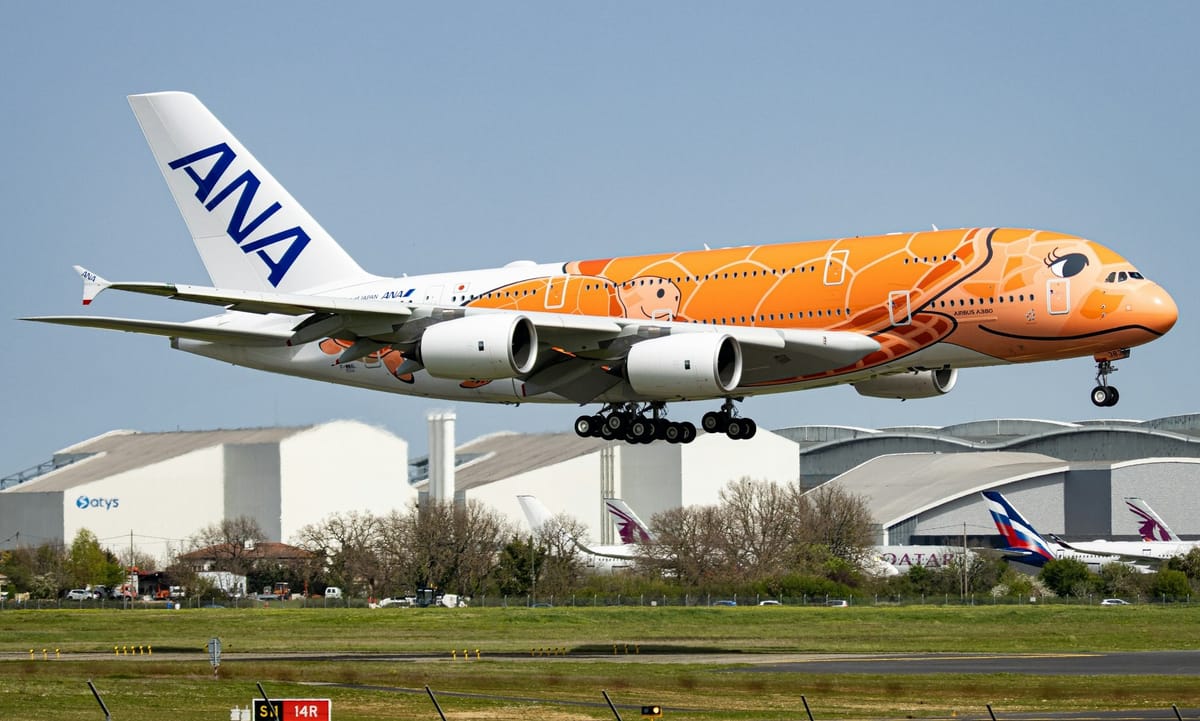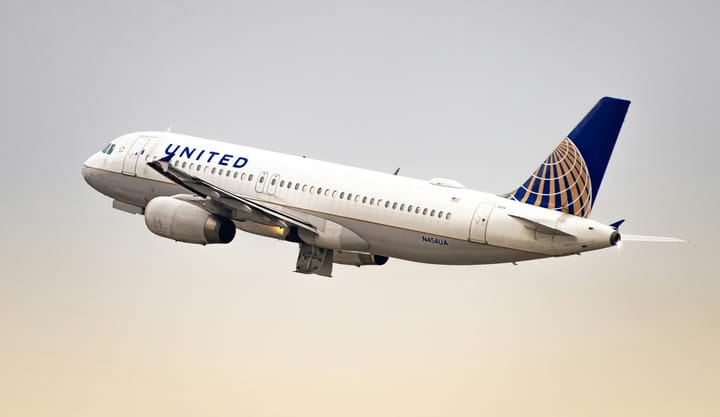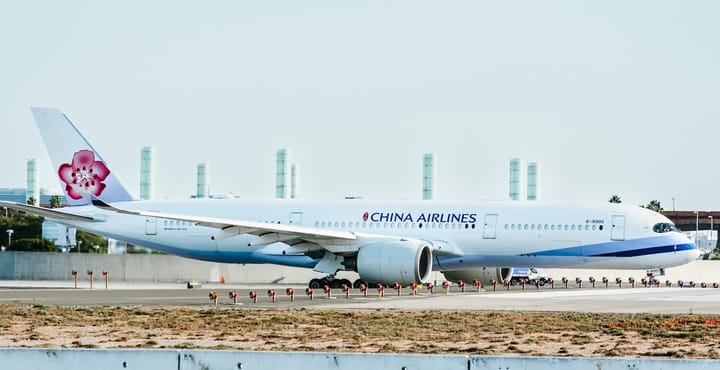All Nippon Airways runs one of the most metrically disciplined networks in Asia—where seat supply, route rebuilds, and cargo integration are aligned less by volume growth than by calibrated utilization and structural yield control.
1. Total Passengers Carried
ANA’s total passenger throughput combines domestic, international, and low-cost segments, amounting to tens of millions annually. In FY2023, the group carried roughly 57.2 million passengers in total, with about 40.8 million on domestic flights and 7.1 million on its international network. LCC subsidiaries (e.g. Peach) added several million more travelers. These volumes position ANA among Asia’s largest carriers by passenger count.
"FY" refers to its Fiscal Year — a 12-month reporting period that typically runs from October 1 to September 30. For example, FY2025 covers the period from October 1, 2024, to September 30, 2025. This timeline is used to report key metrics like passenger numbers, fleet size, and revenue.
After a severe mid-decade drop, ANA saw a steep recovery in traffic. Domestic volumes rebounded from under 18 million in FY2021 to over 42 million by FY2023, while international traffic climbed from less than 1 million to over 9 million in the same span. This rebound reflects pent-up demand and strategic route restorations. By FY2023 ANA’s passenger numbers approached the FY2019 levels (42.9M domestic, 9.4M international), meaning almost full recovery of network usage.
Domestically, ANA’s network spans major hubs like Tokyo-Haneda and Osaka-Kansai, plus roughly fifty secondary airports. Domestic capacity was rebuilt in recent years: by FY2023 ANA’s domestic ASK was about 54.2 billion seat-km, roughly 93% of the FY2019 level. The airline also targeted seasonal leisure demand, planning special fare promotions to capture travel surges for events like the 2025 Osaka Expo in Kansai. These measures and a focus on popular holiday routes helped fill seats and sustain domestic passenger counts.
On the international side, ANA has gradually ramped up long-haul service. FY2023 international ASK was 53.3 billion seat-km, about 77% of FY2019 capacity, reflecting restoration of key routes. The airline launched new Haneda–Milan, –Stockholm and –Istanbul routes in late FY2024 to broaden its European network. It also formed a joint venture with Singapore Airlines (announced April 2024) to improve connectivity. These network expansions – plus ANA’s Star Alliance partnerships – support higher passenger flow volumes as global travel resumes.
Throughout the recovery, ANA has maintained a strong brand image. It remains a consistent winner of industry awards. For example, ANA has earned SKYTRAX’s 5-Star Airline rating for the twelfth consecutive year. In 2023 ANA also claimed Cirium’s On-Time Performance Award for the Asia–Pacific region (its fifth year in a row). These accolades underline the airline’s emphasis on punctual operations and service quality even as passenger traffic grows.
2. Available Seat Kilometer (ASK)
ASK represents the airline’s seat-kilometer capacity. Over the past five years ANA’s ASK has tracked its fleet and network changes. In FY2023 ANA offered about 54.2 billion ASKs domestically and 53.3 billion internationally. These were roughly 93% and 77% of FY2019, showing how fast capacity grew. The domestic market restored supply sooner (about 85% by FY2022, ~93% by FY2023) while international ASK rebuilt more gradually.
Fleet renewal has driven much of this recovery. ANA is replacing older widebodies with newer, more fuel-efficient models. For FY2025, ANA plans to introduce two Boeing 787-10s, one 787-9, one 737-8, five A320neos and a Dash-8Q400, while retiring two 777-300s and three A320-200s. This shift to modern jets boosts seat-km per flight and lowers fuel burn and unit costs. Consequently, ANA can expand total ASK more efficiently by using higher-capacity, longer-range aircraft on many routes.
ANA allocates ASK by route demand. Its mid-range domestic flights now often use new 737-8 jets, adding seat capacity on busy city routes. The fleet mix (narrowbodies for short hops, 787/777 for long-hauls) lets ANA match aircraft to market needs. Its LCC affiliate (Peach) carries many short-haul travelers, increasing group capacity without using mainline slots. Together these network and fleet choices optimize available seat-kilometers for demand.
ANA has also carefully balanced ASK growth with demand. In FY2023 its domestic ASK (~54.2B) and international ASK (~53.3B) were still below peak, so maintaining high utilization was crucial. By tweaking flight frequency and aircraft size, ANA kept ASK in line with bookings. For example, it held domestic ASK near FY2019 levels before gradually scaling up international capacity.
3. Revenue Passenger Kilometer (RPK)
RPK measures actual passenger traffic (passengers × distance). In FY2023 ANA’s domestic RPK was about 38.06 billion passenger-km, nearly recovering to the FY2019 figure of 39.50B. International RPK was ~41.19B (vs FY2019’s 50.22B). Domestic travel thus returned to roughly 96% of pre-downturn volume, while international traffic reached around 82%. This gap reflects how domestic demand bounced back faster, with international traffic only gradually returning.
Restoring RPK involved both capacity planning and demand stimulation. ANA shifted aircraft to high-yield markets as travel resumed, for example focusing widebodies on trans-Pacific and intra-Asia routes. The airline’s strategy explicitly targets capturing inbound tourism and business travel to boost passenger revenues. Alliances and joint ventures (Star Alliance partners, and agreements with United and Lufthansa) along with fare promotions also helped stimulate bookings. Collectively these efforts significantly raised ANA’s RPK as global travel recovered.
Domestically, ANA emphasized stimulating leisure travel to bolster RPK. The company planned promotions (such as its “ANA SUPER VALUE SALE”) and expanded service for events like the Osaka Expo 2025, anticipating higher inbound and domestic demand. These measures helped load more passengers onto flights. As a result, domestic RPK nearly caught up with ASK, indicating that increased flight frequencies and fare deals were effectively converted into passenger traffic.
By FY2023 the trends in RPK underscored ANA’s recovery. Domestic traffic has nearly normalized, and international RPK is steadily climbing back toward pre-2019 levels. The carrier’s mid-term plan assumes continued growth in Asian and North American travel as barriers lift. In essence, tracking RPK shows how ANA’s route and marketing initiatives (new services, alliances, promotions) are translating into actual passenger volume on both short-haul and long-haul services.
4. Passenger Load Factor (%) Analysis
Load factor (LF) is the ratio of RPK to ASK. In FY2023, ANA’s domestic LF was about 70.2% and international LF about 77.3%. Both figures are a few percentage points higher than FY2019’s 67.5% (domestic) and 72.9% (international). This improvement means ANA is filling a higher share of seats on its flights than before, reflecting disciplined capacity management as traffic recovered.
Maintaining high LF is a key efficiency lever. With ASK still under maximum, a high LF helps improve yields. ANA’s scheduling aimed to boost LF: it limited excess flights and used promotional fares when needed to fill seats. Even during its ramp-up in FY2022–23, load factors stayed in the 60–70% range. Sustaining these LF levels while growing the network is challenging, so ANA continually refines its timetables and pricing to avoid overcapacity.
5. Cargo & Mail Volume (Tons)
In the airfreight business, ANA tracks cargo and mail tonnage separately for international and domestic routes. In FY2023 ANA carried about 978,219 tonnes of international cargo (down from 1,244,924t in FY2019) but a rising 477,081t domestically.
Domestic cargo volume therefore grew roughly 28% over five years, reflecting strong intra-Japan shipping. Mail tonnage (primarily postal parcels) also rose modestly – about 34,000t domestic and 33,800t international in FY2023. Together, these figures show how ANA’s combined cargo/mail operations shifted: global freight demand softened, while domestic freight stayed robust.
This divergence stems from market factors. The mid-term outlook expects continued demand for semiconductors, electronics and autos in Asia-Pacific, even as global trade patterns fluctuate. ANA responded by maximizing bellyhold usage on remaining passenger flights. The airline will also integrate Nippon Cargo Airlines into its operations, adding dedicated freighter capacity and expanding its logistics network. These moves indicate ANA’s strategy to capture key industrial cargo flows.
To strengthen cargo handling and sustainability, ANA invested in new infrastructure. It opened the “ANA Cargo Base+” facility at Narita with expanded temperature-controlled storage, targeting perishables and pharmaceuticals. The airline also introduced the first plastic-sheet recycling program for air cargo, reusing protective cargo covers in new sheets. These initiatives (cited when ANA won a Japanese Environment Award in 2023) improve operational efficiency and reduce waste in cargo operations.
Looking ahead, ANA will lean on cargo and mail as steady revenue streams. Internationally, its extensive route network serves major trade flows across Asia, Europe, and North America. Domestically, ANA can allocate flights – or dedicate freighters (via NCA) – to meet high-demand freight lanes.




Comments ()